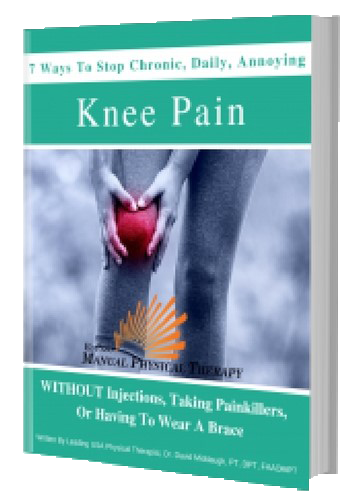TAP TO CALL (915) 503-1314

TOP 5 REASONS FOR A LOSS OF RANGE OF MOTION AFTER KNEE REPLACEMENT
Here are the top five reasons for a loss of range of motion after having a knee replacement surgery. Not having the ability to fully extend or flex your knee joint can lead to some frustrating limitations. And I’m talking about problems like not being able to reach your foot because you can’t bend your knee enough, limping if you can’t straighten your knee enough, that can cause problems in other body parts.
Because limping just throws off from mechanics. You can also get stiffness in the joint, and then there’s disappointment in your knee replacement, not going like you’re expected and worry over the possibility of needing another knee replacement to fix this issue. So reason number one could be from effects of the surgery.
In some situations, the way the surgery was done, whether intentional or unintentional, may leave the knee joints, without the ability to fully extend or bend, it could also be a fit of the prosthetics, the metal parts that were installed into the knee joint may not be the best ideal fit.
Or it could be that that was the best that they had at that time, there was no other options. So that’s what you ended up getting. Most surgeons doing, the replacements are very experienced in what they’re doing and very knowledgeable about doing the replacements. And so it’s rarely ever the surgeons fault in messing things up, it’s more so that that’s the best they could do with what they had at the time.
Reason number two is not enough exercise, after having the knee replacement surgery, there’s a window of time for healing when it’s most appropriate to get the full range of motion. Because after that tissues are much harder to adapt to gaining more motion, if for some reason, during this window of healing, there’s problems like complications with the surgery, possibly an infection, exercise may not be the priority at that time, because there may be a bigger problem that you need to deal with.
This could lead to a limitation in a range of motion later after you’re done with the complications. And you’re recovering normally. In some situations, it could be the patient didn’t follow through with their exercise plan after doing the surgery for reasons that are out of their control.
It could be issues like not having access to health care in the area, not being able to afford it not being able to have insurance, it can cover it not having the transportation to get there, or simply there not being enough health care professionals in the region to service everyone. And there could be delays in getting to the health care that’s needed. And every now and then there’s a patient that just is not the greatest at complying with all that they’re supposed to do a coordinator, surgeons recommendations and protocols after surgery.
Reason number three is a history of a loss of motion in the knee. If you’re going into a knee replacement, and you’ve been dealing with a loss of motion, like you can’t bend your knee or straighten your knee for years leading up to the surgery, it’s very possible that you carry over that loss of motion into the situation after having had the knee replacement surgery.
Of course, you want to do all that you can during your rehabilitation after surgery. So you can maximize the motion that you can get during that healing window. But in some cases, for some reason, it just carries over. And there’s not much you can do. If you haven’t had a knee replacement surgery yet.
Be sure to make your surgeon aware that you’ve been dealing with an inability to straighten your knee or bend your knee all the way for whatever length of time it is, so that they can factor that into your care plan, and possibly make adjustments to get you the best outcome as far as your range of motion.
And reason number four is joint stiffness. And you have to realize that there’s many things crossing the joint, the joint capsule is what I’m talking about that can cause a joint sickness, there’s also muscles, tendons and ligaments across the knee joint. But when a knee replacement is performed, in order to access the bones that they’re going to cut off and put the implants on, they have to cut open the knee joint capsule, and the capsule is basically ligament like structures that hold the joint fluid inside.
After the surgery when you’re healing that knee joint capsule has to heal and normalize itself again. But if it doesn’t get its normal mobility that it’s supposed to get that could be causing a limitation in your motion. And the thing is when you’re stretching to get more bending or more straightening after surgery, people often will say they feel it in their thigh muscles.
They feel the stretch happening on the quads, when they bend their knee and then on the hamstrings when they straighten their knee. But sometimes what’s limiting the motion is the joint capsule itself and in order to gain more motion from the joint capsule, and it usually takes a specialist like myself like a manual physical therapist to get their hands on the joint in a certain way and feel where the limitations are to get the mobility that’s needed out of the joint capsule.
If your therapist is not getting their hands on your knee joint to account for the knee joint capsule stiffness, you may consider visiting a specialist at least for a few visits to ensure that you have no limitations coming from the joint capsule.
Reason number five are muscle imbalances. Muscle imbalances are the most overlooked problem when it comes to knee joint replacements and the problems before that like knee arthritis, or meniscus tears. And put simply muscle imbalances are when there’s muscles that are compensating usually in the thigh.
Very often the quad muscles, they’re working too hard, because of weakness and other muscles, so they’re compensating. But when they’re over dominant as a result of the compensation, they can add a lot of compression at the knee joints. And that compression might limit how much motion you can go through.
I see it all the time where we work on muscle imbalances here in the clinic, and it allows people to get more range of motion without even stretching, correcting the muscle imbalance simply takes working on key muscle groups. In order to put the muscles back in balance, we have to wake up those weak muscles and strengthen them so that you can act more normally in your leg.
I talk extensively about muscle imbalances on this channel, specifically in people that have had knee replacements and those that have knee arthritis and are considering getting a knee replacement as well. I’ve got a knee replacement help playlist and a knee arthritis pain help playlist. Both are linked down the description below.
I also offer online programs, there’s one called the failed knee replacement recovery program. And then there’s another called the knee arthritis recovery program. Both of these programs are designed to comprehensively take you through correcting the muscle imbalance as well as calming down the pain if you’re in a lot of pain right now, so that you can get to a point where you can begin to fix the muscle imbalance.
I hope this video was helpful for you. If it was please give us a thumbs up. Please share this with somebody you think needs to hear this. And don’t forget to subscribe and turn on our notification bell so that you don’t miss out on any of the helpful videos that we post each and every week. Thanks so much for watching, and I’ll see you in the next video. Bye bye!
Would You Like To Talk With A Specialist?
Appointments and Questions Call: (915)503-1314
EL PASO MANUAL PHYSICAL THERAPY
2601 E. Yandell Drive, Suite 232
El Paso, Texas 79903
© 2023 El Paso Manual Physical Therapy, PLLC, All Rights Reserved
